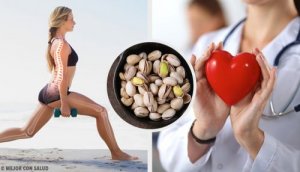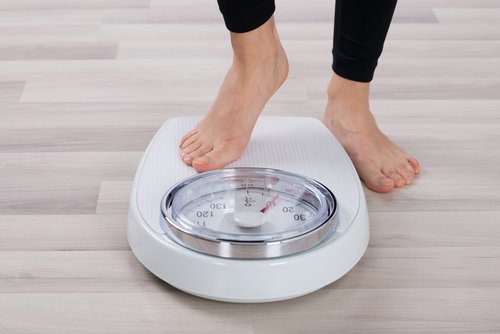Ten Reasons to Eat More Pistachios


Written and verified by the nutritionist Eliana Delgado Villanueva
You’ve got to eat more pistachios, the small nuts with low water content. These nuts grow on pistachio trees, called Pistaciaceae in scientific terms. The pistachio tree originated in Central and Minor Asia. Over time, it spread to other lands.
Today, it’s a popular nut that can be eaten raw or cooked in savory or sweet dishes. In addition, according to data from SELF Nutrition Data, they contain many nutrients, such as:
- Vitamins (E, folic acid, and thiamine)
- Minerals (copper, potassium, magnesium, calcium, and iron)
- Protein
- Fiber
- Fatty acids
Pistachios are purple on the outside and green on the inside, covered by a shell that opens in the middle. The shell is easy to open, though sometimes it’s completely closed and hard to break open. Below, we tell you ten reasons why you should eat pistachios. If you have any doubt, we recommend consulting a nutritionist.
1. Eat pistachios if you’re diabetic

In fact, a study published in The Review of Diabetic Studies concluded that eating pistachios as snacks can help control glycemic index, blood pressure, obesity, and inflammation in diabetic patients.
2. Eat pistachios, these help reduce your risk of heart disease
Pistachios contain healthy fats that can contribute to the prevention of heart disease. An investigation published in the journal Acta BioMedica determined that the consumption of pistachios favors the reduction of high total cholesterol and bad cholesterol levels. In turn, if you eat pistachios, they may help increase good cholesterol (HDL) levels.
On the other hand, this food contains the amino acid L-arginine, which is converted into nitric oxide in the body. Thanks to this, it promotes blood vessel health and prevents arterial stiffness.
3. They help you manage your weight

Pistachios can be a healthy snack when your goal is to lose weight. Thanks to their dietary fiber and protein content, they help increase the feeling of satiety and decrease the need for overeating between meals.
The benefits are even greater if you consume them in their shell. A study published in the journal Appetite determined that individuals who ate pistachios in shells consumed 41% fewer calories than people who ate pistachios without shells.
4. Eat pistachios for their fiber content
Pistachios contain up to three grams of fiber per 28-gram serving. For this reason, consuming them regularly may help improve your digestion and the activity of healthy gut bacteria.
Specifically, it’s a prebiotic food. Thus, it feeds the intestinal microbiota. A study published in the British Journal of Nutrition stated that eating pistachios increases the amount of butyrate producing-bacteria in the intestine, even more so than almonds.
5. They’re good for your vision

Due to its lutein, zeaxanthin, vitamin E, and vitamin B2 content, pistachios decrease the risk of vision diseases. According to information published in the American Optometric Association, these substances reduce the odds of developing eye conditions, such as age-related macular degeneration and cataracts.
6. They strengthen bones
Studies conducted in rodents allowed researchers to observe the beneficial effects of pistachios on bone density. The publication in FASEB Journal highlighted that this food contains calcium, proteins, fatty acids, and various phenolic antioxidants that are determinants in bone maintenance and development.
Nevertheless, the evidence is still limited. Thus, this subject requires further research. Despite this, pistachios can be included as part of a diet to take care of bone health.
7. They help you have strong teeth

Due to the calcium pistachios contain, they can also benefit dental health. Although they can’t cure dental diseases, they may make them stronger and improve their appearance.
8. Haircare
Thanks to the fact that they’re rich in fatty acids, proteins, and antioxidants, this variety of nuts is a good complement for hair care. According to a publication in Nutrition Today, they contain more essential amino acids than any other nut.
As some know, proteins and amino acids are important to keep your hair strong and flexible. The adequate assimilation of this nut favors the control of hair loss and weakness.
9. Young appearance

One way to keep your skin in good shape is to eat pistachios. That’s due to the vitamin E and antioxidants they contain, which protect your skin from UV rays and the aging process.
Thus, in addition to your care and cleaning routines, don’t forget that eating pistachios may help your skin healthy and hydrated.
Check out these Tips to Keep Your Skin Looking Young at 40
10. Promote brain health
A study published in the FASEB Journal found a positive relationship between nut consumption and brain health. Specifically, these properties stem from the fact that they’re rich in flavonoid substances, which promote neurogenesis, improved blood flow, and angiogenesis to stimulate brain health.
Important things to keep in mind when you eat more pistachios
Pistachios help care for your body, from head to toe, which is why you should include them in your diet. However, you have to make sure to not eat them in excess, as they can affect your health.
Of course, you also have to make sure you’re not allergic to them since an allergy can lead to immediate symptoms, such as:
- Rashes
- Swelling
- Hives
- Respiratory problems
In conclusion, this nut is a great source of vitamins and minerals for a healthy body, as long as you eat pistachios in moderation and don’t have an allergy.
All cited sources were thoroughly reviewed by our team to ensure their quality, reliability, currency, and validity. The bibliography of this article was considered reliable and of academic or scientific accuracy.
- Parham, M., Heidari, S., Khorramirad, A., Hozoori, M., Hosseinzadeh, F., Bakhtyari, L., & Vafaeimanesh, J. (2014). Effects of pistachio nut supplementation on blood glucose in patients with type 2 diabetes: a randomized crossover trial. The Review of Diabetic Studies : RDS, 11(2), 190–196. https://doi.org/10.1900/RDS.2014.11.190
- Kasliwal, R. R., Bansal, M., Mehrotra, R., Yeptho, K. P., & Trehan, N. (2015). Effect of pistachio nut consumption on endothelial function and arterial stiffness. Nutrition, 31(5), 678–685. https://doi.org/10.1016/j.nut.2014.10.019
- Bulló, M., Juanola-Falgarona, M., Hernández-Alonso, P., & Salas-Salvadó, J. (2015). Nutrition attributes and health effects of pistachio nuts. British Journal of Nutrition, 113(S2), S79–S93. https://doi.org/10.1017/S0007114514003250
- Honselman, C. S., Painter, J. E., Kennedy-Hagan, K. J., Halvorson, A., Rhodes, K., Brooks, T. L., & Skwir, K. (2011). In-shell pistachio nuts reduce caloric intake compared to shelled nuts. Appetite, 57(2), 414–417. https://doi.org/10.1016/j.appet.2011.02.022
- Ukhanova, M., Wang, X., Baer, D. J., Novotny, J. A., Fredborg, M., & Mai, V. (2014). Effects of almond and pistachio consumption on gut microbiota composition in a randomised cross-over human feeding study. British Journal of Nutrition, 111(12), 2146–2152. https://doi.org/10.1017/S0007114514000385
- Wickman, BE, Rochester, E., Hauffe, L., Kern, M., Hong, MY, Liu, C. y Hooshmand, S. (2018). Efecto de pistachos y nueces mixtas sobre la densidad ósea y la expresión de genes osteogénicos en ratas macho jóvenes. FASEB Journal .
- Mandalari, G., Bisignano, C., Filocamo, A., Chessa, S., Sarò, M., Torre, G., … Dugo, P. (2013). Bioaccessibility of pistachio polyphenols, xanthophylls, and tocopherols during simulated human digestion. Nutrition, 29(1), 338–344. https://doi.org/10.1016/j.nut.2012.08.004
- Lee Berk, Everett Lohman, Gurinder Bains, Kristin Bruhjell, Jessica Bradburn, Nikita Vijayan, Sayali More, Krisha Patel, Sayali Dhuri, Siddarth Mourya, Gyuhyun Park, Ankita Gujaran and Shruti Nikam. Nuts and Brain Health: Nuts Increase EEG Power Spectral Density (μV&[sup2]) for Delta Frequency (1–3Hz) and Gamma Frequency (31–40 Hz) Associated with Deep Meditation, Empathy, Healing, as well as Neural Synchronization, Enhanced Cogn. FASEB, 2017
This text is provided for informational purposes only and does not replace consultation with a professional. If in doubt, consult your specialist.








